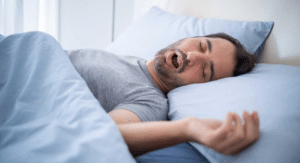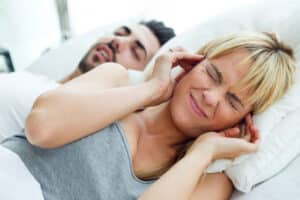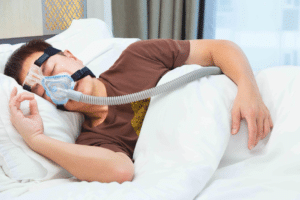Sleep apnea causes people to stop breathing while they sleep, sometimes for several seconds at a time. It often leads to loud snoring, gasping, and constant fatigue. Most people don’t even realize they have it. The real concern isn’t just the condition itself but how common is sleep apnea among adults and even children. Understanding the numbers can help raise awareness and encourage early treatment.
What Is Sleep Apnea and How Common Is It?
Sleep apnea is a condition that causes breathing to stop and start repeatedly during sleep. Most people don’t realize they have it. It often leads to loud snoring, choking, poor rest, and serious health issues. There are different types of sleep apnea, but obstructive sleep apnea is the most common.
Now that you know what it is, let’s talk about how common it really is.
Sleep Apnea Is More Common Than You Think
Sleep apnea affects millions of Americans. It often goes undiagnosed because many people think poor sleep is normal. Studies show that around 25 million adults in the United States live with obstructive sleep apnea. The numbers continue to grow.
Sleep Apnea Affects People in All Age Groups
Adults
Obstructive sleep apnea shows up most often in adults. About 24% of adult men and 9% of adult women deal with it. Risk increases with weight gain and age.
Children
Around 1 to 5% of children also suffer from sleep apnea. It may go unnoticed because it mimics other conditions, such as ADHD or behavioral issues.
Seniors
Older adults face a higher risk. Nearly one in three people over age 65 may have sleep apnea. As the body changes with age, the muscles in the throat can become weaker, leading to blocked airways during sleep.
Obesity Increases the Risk
Sleep apnea often connects to body weight. Over 50% of people with obesity also have some form of sleep apnea. Extra tissue in the neck can block the airway, especially when muscles relax during sleep. Losing even a small amount of weight can improve symptoms.
Sleep Apnea Often Goes Undiagnosed
Nearly 80% of moderate to severe cases go undetected. People blame stress, screen time, or work for their tiredness. They may snore or gasp in their sleep, but they don’t connect it to a breathing disorder.
Even those who live with a partner might not know. While the partner may hear snoring, they often don’t realize the health risks involved.
Global Impact of Sleep Apnea
Sleep apnea isn’t just an issue in the U.S. Studies estimate that nearly 1 billion people around the world live with some form of sleep-disordered breathing. It affects both developed and developing countries. As obesity rates rise, so do sleep apnea cases.
Gender and Racial Differences
Men vs. Women
Men are more likely to be diagnosed, but that doesn’t mean women are in the clear. Women often show different symptoms, like fatigue, insomnia, or mood changes. These symptoms may get misdiagnosed as depression or anxiety.
Race and Ethnicity
African Americans, Hispanics, and Native Americans may have higher rates of sleep apnea compared to white populations. Genetics and access to healthcare both play a role. These groups also face higher rates of obesity, which can contribute to the condition.
Health Problems Linked to Sleep Apnea
Untreated sleep apnea raises the risk for serious health conditions. These include:
-
High blood pressure
-
Stroke
-
Heart disease
-
Type 2 diabetes
-
Depression
Sleep apnea also weakens the immune system. It lowers oxygen levels, increases stress hormones, and damages heart function over time.
Impact on Daily Life
Sleep apnea doesn’t only affect health. It makes daily life harder. People feel tired even after a full night of sleep. They may fall asleep at work or while driving. Sleep apnea contributes to thousands of road accidents every year.
It also affects memory, focus, and mood. People often feel irritable or anxious without understanding why.
Diagnosis Has Become Easier
Getting diagnosed used to mean spending a night in a sleep lab. Now, many clinics offer home sleep tests. These devices track breathing, oxygen levels, and movement while you sleep. This simple test helps doctors confirm if you have sleep apnea and what type it is.
Common Signs of Sleep Apnea
Many people don’t know what to watch for. Here are the top signs:
-
Loud snoring
-
Choking or gasping during sleep
-
Waking up with a dry mouth
-
Morning headaches
-
Trouble focusing during the day
-
Feeling sleepy after a full night’s rest
-
Mood swings or depression
If these symptoms sound familiar, it’s time to get checked.
How Treatment Helps
Treatment depends on the severity of the condition. For many, the go-to option is a CPAP machine. It delivers air pressure that keeps the airway open while you sleep. Other patients may benefit from an oral appliance. This fits like a retainer and holds the jaw forward to prevent blockage.
Surgery is another option for severe cases that don’t respond to other treatments.
Orthodontists Can Help Too
In some cases, your orthodontist may be the first to spot signs of sleep apnea. If your jaw structure contributes to airway blockage, they may recommend an oral appliance. These devices are easy to use, travel-friendly, and effective for many patients who struggle with CPAP machines.
Awareness Has Grown in Recent Years
People talk more about sleep apnea today than they did a decade ago. COVID-19 pushed breathing health into the spotlight. More people took sleep seriously and got tested. Telehealth services also made it easier to consult with sleep specialists from home.
Final Thoughts
Sleep apnea affects more people than you might expect. It touches lives across all ages, races, and lifestyles. The danger lies in how quietly it creeps in and how long it can go untreated. Knowing how common it is can help you recognize it in yourself or someone close to you.
Book an Appointment with Smiles by Lorino
Smiles by Lorino offers oral appliance therapy for sleep apnea patients who want alternatives to CPAP machines. If you snore, wake up tired, or feel off during the day, we can help. Visit our offices in Franklin Lakes, Long Hill, Belleville, or Wayne to get started. Call us today to schedule your consultation.
Frequently Asked Questions About Sleep Apnea
What causes sleep apnea?
Sleep apnea happens when the airway becomes blocked or when the brain fails to send proper signals to the muscles that control breathing. Common causes include excess weight, narrow airways, enlarged tonsils, or certain medical conditions.
How do I know if I have sleep apnea?
Many people only find out after a partner notices loud snoring, gasping, or choking during sleep. You might also notice constant tiredness, morning headaches, or trouble concentrating. A sleep study confirms the diagnosis.
Is sleep apnea dangerous?
Yes. Untreated sleep apnea can lead to serious health problems, such as high blood pressure, heart disease, type 2 diabetes, stroke, and depression. It also raises the risk of car accidents due to daytime sleepiness.
Can children have sleep apnea?
Yes. Children can develop sleep apnea, often due to enlarged tonsils or adenoids. Symptoms may include snoring, restless sleep, behavioral issues, or trouble in school. A pediatric evaluation can help with early treatment.




